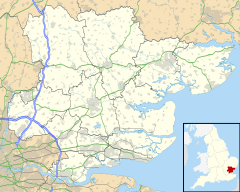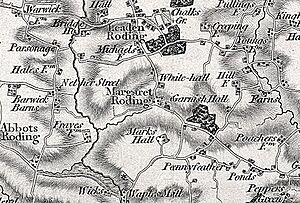Margaret Roding facts for kids
Quick facts for kids Margaret Roding |
|
|---|---|
 Garnish Hall, Margaret Roding |
|
| OS grid reference | TL5971 |
| Shire county | |
| Region | |
| Country | England |
| Sovereign state | United Kingdom |
| Post town | Dunmow |
| Postcode district | CM6 |
| Police | Essex |
| Fire | Essex |
| Ambulance | East of England |
| EU Parliament | East of England |
| UK Parliament |
|
Margaret Roding is a small village in the Uttlesford area of Essex, England. It's one of eight nearby hamlets and villages known together as The Rodings. Margaret Roding is about 7 miles (11 km) north-west of Chelmsford, which is the main town in Essex.
Contents
History of Margaret Roding
How Margaret Roding Got Its Name
The name "Roding" comes from an old word, "Rodinges." This name was first written down in the Domesday Book in 1086. The Domesday Book was a huge survey of England ordered by William the Conqueror. Later, in 1245, the village was called 'Roinges Sancte Margaret'. The "Margaret" part of the name comes from the church in the village, which is dedicated to Saint Margaret.
Over time, people used different spellings like Margaret Roothing or Margaret Rooding. But today, the official name is 'Margaret Roding'.
Old Estates and Owners
Margaret Roding had two main estates, or large areas of land, called 'Roding Margaret' (also known as Barnets) and 'Marcas Fee' (or Marks).
The main house for the Roding Margaret estate was Garnish Hall. This house is to the east of St Margaret of Antioch's Church. For a long time, this estate belonged to the De Vere Earls of Oxford, who were very important noblemen.
The Marcas Fee estate got its name from its owners. Its main house and a private chapel were about a mile south of the church. In 1403, King Henry IV and a bishop named Walter Skirlaw gave this estate to University College, Oxford.
Later, during the time of King James I, both estates were owned by Sir Francis Hubbard. He later sold them in 1672.
Life in the 1800s and Early 1900s
From the 1830s, Margaret Roding was part of the Dunmow Union. This was a system set up to help poor people, but it often meant they had to live and work in a workhouse.
The village church, St Margaret of Antioch, has records going back to 1538. In the 1800s, about 150 people could sit in the church. The church's rector (the main priest) had a home and land called glebe, which helped support them.
A man named James Bentley gave money in 1865. The yearly interest from this money was used to take care of the churchyard and keep the church walls in good shape.
In 1888, a small part of a nearby parish called Good Easter was added to Margaret Roding.
Schools in Margaret Roding
Margaret Roding had a school for poor children that started in 1731. It was supported by money from a farm and a gift from James Bentley.
Later, there was a Public Elementary School for both boys and girls. By 1914, about 40 children usually attended this school. It was made bigger in 1910 so it could teach up to 84 children.
Population and Jobs
The amount of land in the parish changed over time. In 1848, there were about 1,222 acres (4.95 km²) of land. By 1914, this had grown to about 12,285 acres (49.7 km²).
The number of people living in Margaret Roding also changed:
- 1841: 272 people
- 1881: 225 people
- 1901: 210 people
- 1911: 214 people
The main crops grown in the area were wheat, barley, and beans. The soil was heavy clay.
People in Margaret Roding had various jobs. In 1848, there were farmers, a blacksmith, a corn miller, and the person who ran the Horse Shoes public house. By 1914, jobs included a shopkeeper who also ran the Post Office, a carpenter, several farmers, and a paymaster for a local benefit society.



